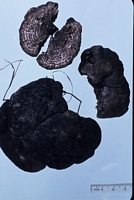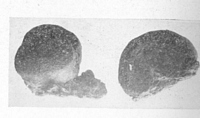|
 Daldinia childiae Daldinia childiae
SynonymsHypoxylon simile
Daldinia concentrica
BiostatusPresent in region - Indigenous. Non endemic
Images (click to enlarge)
Owner: Herb. PDD | 
Caption: Fig. 2881. Hypoxylon simile. |
Description: Stromata: Stromata spherical; 5-50 mm broad; 8-40 mm thick; perithecia inconspicuous; ostioles lower than or more or less equal to stromatal surface, or finely papillate; stromatal surface dull rusty-brown, cinnamon to sienna; granules immediately below stromatal surface rust to orange, or red brown; KOH-extractable pigments rust, deep yellow-brown to orange, or yellowish-green; tissue between perithecia pithy. Tissue below perithecia conspicuous, comprising concentric rings of alternate dark and pale zones; pale zone nongelatinous, solid and pithy when dry.
Perithecia: Perithecia tubular; 0.5-0.6 mm diam.; 1-1.2 mm high.
Asci: Amyloid ring broader than high.
Ascospores: Ascospores 13.5-15.5 µm long; 6-8 µm wide; brown, or pale brown; 0-septate; in side view inequilateral, flattened on one side, not curved; in face view fusoid, or elliptic; ends narrowly rounded. Germ slit straight, spore-length; on concave, curved side of spore. Perispore dehiscent in 10% KOH; smooth or with indistinct transverse thickenings.
Article: (1924). Mycological notes, no. 72. Mycological Writings 7: 1269-1300 Cincinnati:.
Description: Globose, black, about an inch in diameter, surface smooth, black, the ostioles not protruding
nor visible to the eye. Perithecia broad, elongate, contiguous, forming a peripheral layer.
Context brown, carbonous, not at all zoned. This is similar to Hypoxylon fissum (Vol. 7, page
1121, Fig. 2141). Same size, perithecia, context and spores; but this has no sign of a thick
reddish conidial layer found on the American plant. It may however be the same, but we
would not be justified in so referring especially as long as each is known from each country
from a single collection. At any rate both are very rare in their respective countries.
|